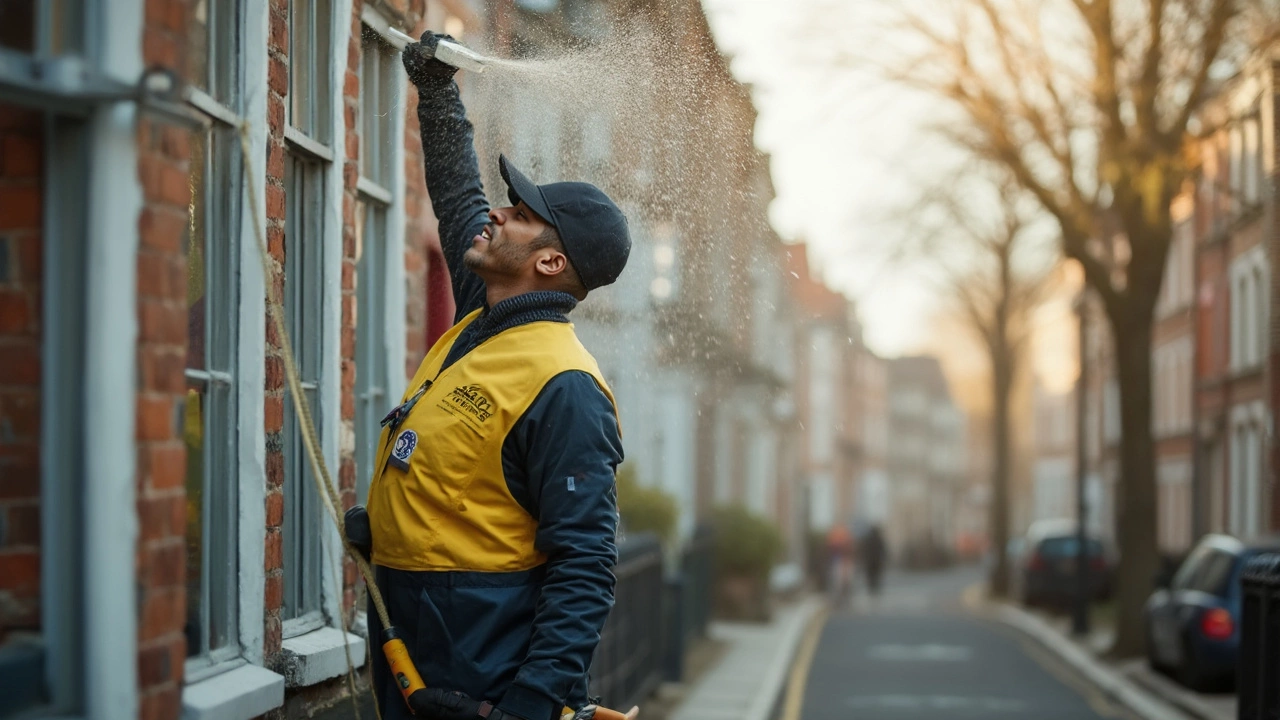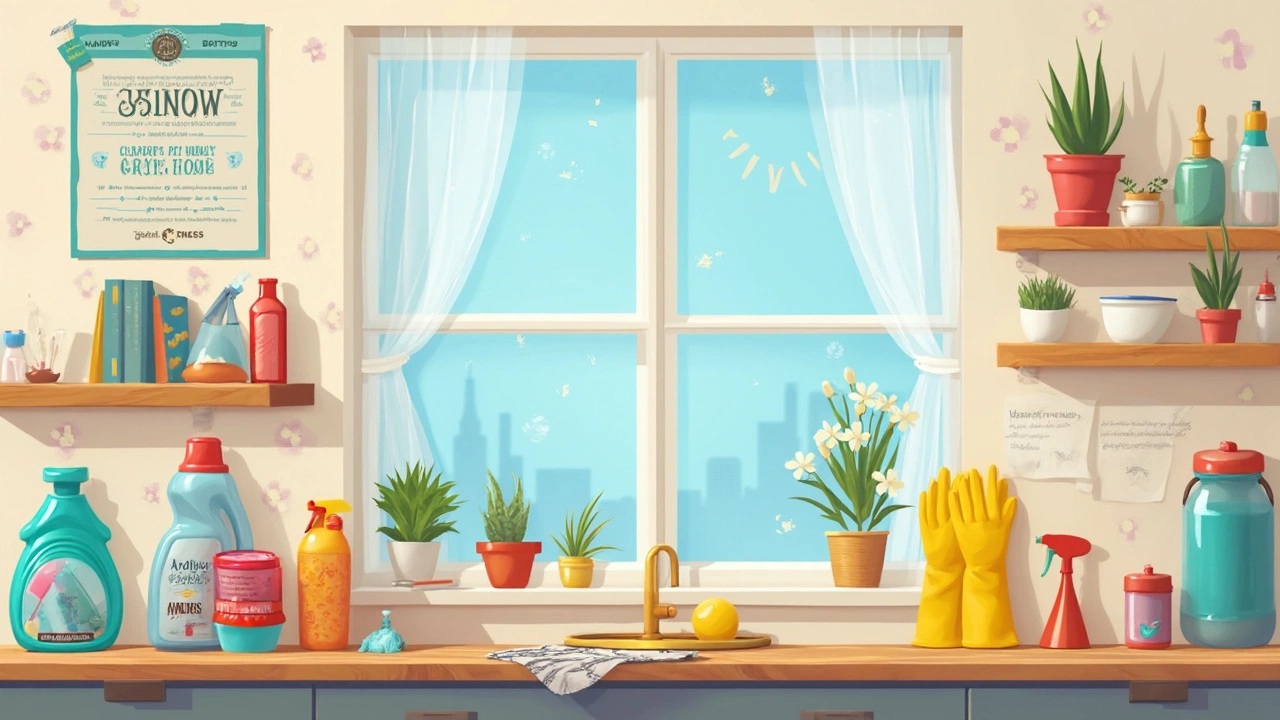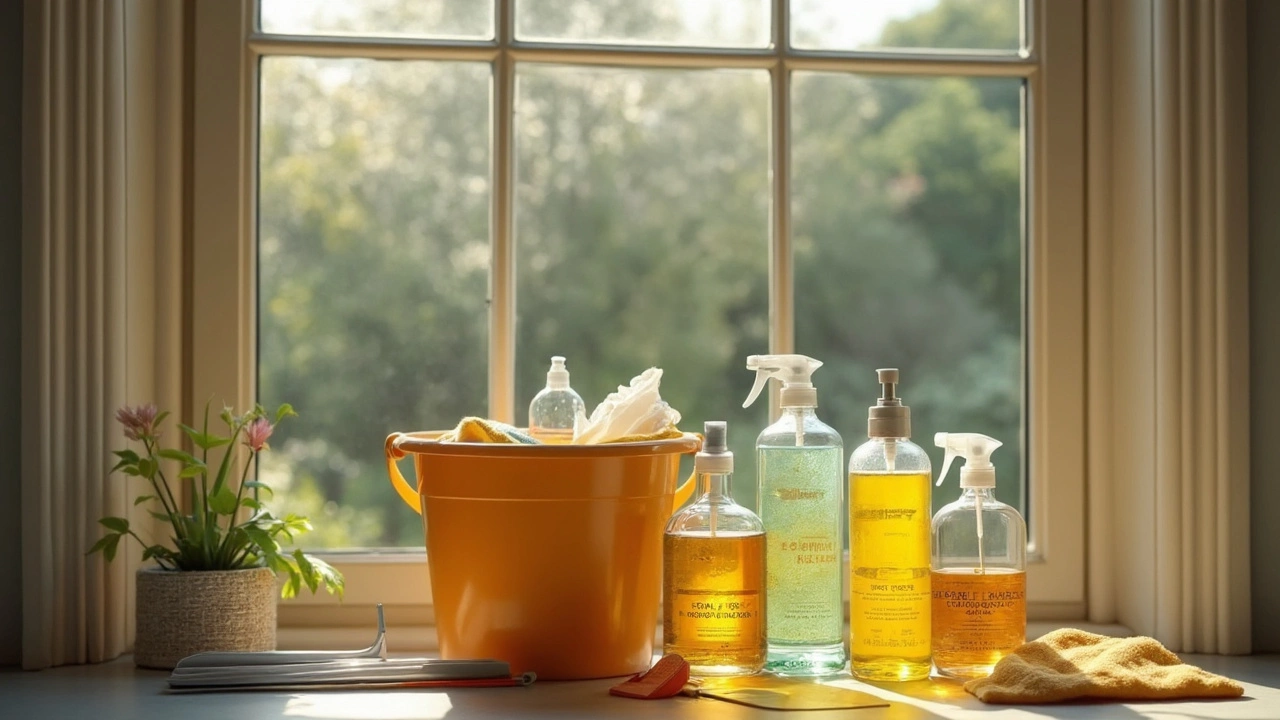Ever looked at your windows and wondered why your scrubbing leaves streaks, while pros leave glass spotless in minutes? Spoiler alert: it’s not just elbow grease. The real trick is what they mix into their water.
Most people think cleaning windows is about just water and maybe some dish soap. But pro window cleaners use specific solutions designed to cut through grime, break down greasy fingerprints, and dry super fast without those pesky streaks. Their base recipe usually starts with purified or deionized water—this stuff has all the minerals taken out. Why? Because minerals in tap water leave behind spots when the glass dries.
- Beyond Just Water: The Basic Solution
- Why Professionals Avoid Common Dish Soaps
- Additives for Streak-Free Windows
- Tools That Make a Difference
- Tips for DIY Success
Beyond Just Water: The Basic Solution
If you ask an experienced window cleaner what's in their bucket, you won’t hear just “water.” The basic mix actually starts with water that’s been run through a purification process—think reverse osmosis or deionization. This gets rid of minerals like calcium and magnesium, which are the main reason you get those ugly spots or chalky marks when glass dries. No minerals, no white spots. In areas with hard water, skipping this step is a recipe for frustration.
But water alone isn’t enough to break down months of grime, bird droppings, or greasy fingerprints. That’s why pros add a dash of specialized cleaning detergent. Unlike the thick or sudsy stuff you use in the kitchen, these detergents are made specifically for windows. They cut grease, disperse dirt, and help the squeegee glide easily. One popular example is Unger Liquid, but there are other pro brands like Ecover and Sörbo soap. These products don’t leave residue, so you’re not trading one mess for another.
Here’s what usually goes in a standard pro window cleaning solution:
- Purified or deionized water (the foundation for a clean finish)
- Professional-grade window cleaning detergent (usually only a few drops per gallon)
For folks who love stats, check out this quick comparison used by cleaners in the field:
| Solution | Mineral Content | Streaks/Spots After Drying |
|---|---|---|
| Tap Water (untreated) | High | Common |
| P urified Water | Low to None | Rare |
| Professional Solution (with detergent) | Low to None | Very Rare |
It’s not about making a bubble bath: too much soap actually messes up the process. The pros keep it simple and measured. The right base not only makes glass sparkling but also gives that extra glide so your squeegee doesn’t skip or drag. Once you’ve got the window cleaning basics right, everything else is just technique.
Why Professionals Avoid Common Dish Soaps
A lot of folks reach straight for the dish soap when it comes to window cleaning, thinking it’ll do the trick. Sure, dish soap is great for greasy plates, but it’s honestly not what the pros use for a few pretty big reasons. First off, most dish soaps are packed with extra stuff like moisturizers and scents—good for your hands, not great for glass. Those additives leave behind a film, which causes streaks and attracts dust. So instead of sparkling clean, you get cloudy and sticky.
Another issue? Dish soaps suds up—a lot. You might think more bubbles mean more clean, but all those suds can stick to your *window cleaning* tools and the glass itself. This makes rinsing a chore and usually leads to even more streaks or spots once things dry. Professional solutions, on the other hand, are made to rinse off clean and disappear without a trace.
Plus, dish soap builds up in squeegees and buckets over time. The residue can gunk up your tools, making them less effective and forcing you to replace them sooner. Professionals want their gear to last, so they stick to cleaners that don’t leave buildup behind.
To sum it up, pro window cleaners avoid common dish soaps because:
- They leave films and streaks on the glass
- They attract dust and dirt after cleaning
- Too many suds make rinsing and wiping harder
- Regular use shortens the lifespan of essential cleaning tools
So if you’re hoping for that streak-free, pro-level finish, you’ll want to skip the dish soap and go for a purpose-made window solution instead. It’s a simple change, but it makes all the difference.

Additives for Streak-Free Windows
No one likes wiping a window for half an hour, only to see swirly marks or annoying streaks when the sun hits. This is where the right additives come in. Professional window cleaners know that plain soap and water just isn't enough for a perfect finish.
The most common additive in a pro's bucket is a specially formulated window cleaning detergent. These aren't your garden variety dishwashing liquids. They’re made to create just enough suds and, more importantly, cut through sticky dirt while rinsing clean with no residue. Popular brands you’ll hear about include Unger and Ettore Squeegee Off—designed for a streak-free result every time. These solutions break surface tension, so dirty water slides right off with your squeegee.
Some pros also add a dash of vinegar. A small splash can help dissolve hard water spots and mineral build-up, but too much makes everything smell like a salad, so it’s always used sparingly. On colder days, a shot of isopropyl alcohol or a few drops of windshield wiper fluid keeps the water from freezing on the glass; handy if you're cleaning windows in winter.
Here's a quick look at the most common window cleaner additives and what they do:
| Additive | Main Benefit | Typical Amount Used |
|---|---|---|
| Professional window detergent | Removes dirt and grease, adds slip | 1-2 oz per gallon |
| Vinegar | Breaks down mineral deposits | 1/4 cup per gallon |
| Isopropyl alcohol | Anti-freeze in cold weather | 2-4 oz per gallon |
| Dish soap (mild) | Extra cleaning, more suds | 1-2 drops per gallon |
Using too much of any additive can backfire. For example, too much detergent can leave a film, which is exactly what you don't want when going for a streak-free shine. So pros consistently measure out their extras, aiming for just enough to boost cleaning power without leaving anything behind.
Last point: always mix these into purified or deionized water. Even the best additives won’t matter if you’re using mineral-heavy tap water, which leaves those ugly spots once everything dries.
Tools That Make a Difference
If you’ve ever watched a pro breeze through a big plate glass window, you know it’s not just about what’s in their bucket—it’s also about the gear they’re packing. The right tools save time, stop streaks, and nail that crystal-clear look every time. Let’s break down what’s always in the pro’s kit.
The squeegee is the MVP. Professionals use high-grade squeegees with replaceable rubber blades. These blades matter—a fresh, sharp edge on rubber means no leftover water and zero streaks. Changing blades often (sometimes several times a day) is common on big jobs.
Next up are scrubbers, usually called window "strip washers" or "applicators." Picture a microfiber sleeve wrapped over a handle. They grab grime without scratching, hold plenty of solution, and let you spread it quickly over wide glass. Some applicators have built-in scrub pads at the ends to tackle sticky gunk.
For edges and corners, pros never forget detailing cloths—microfiber or surgical towels—because paper towels and tees leave lint or fibers behind. These cloths wipe up excess water from edges for that perfect finish. Bucket-on-a-belt rigs let cleaners carry these tools hands-free for speed, especially on tall buildings or ladders.
- Extension poles are game-changers for high or awkward windows. They attach to squeegees and washers, sometimes stretching over 30 feet, so ladders aren’t always needed.
- Water-fed poles with soft brushes are a newer tool, popular for commercial jobs. They use purified water pumped through the pole, letting pros wash and rinse massive windows without coming back down every minute.
- Glass scrapers help with tough spots—think paint drips or dried bird mess. But pros use scrapers carefully and only on scratch-safe glass since the wrong move can ruin the whole pane.
Here’s how some of these tools stack up on real jobs:
| Tool | Average Pro Usage (%) | Main Benefit |
|---|---|---|
| Squeegee | 99 | Streak-free finish, quick removal |
| Microfiber Applicator | 94 | Even solution spread |
| Extension Pole | 87 | Reach without ladder |
| Water-Fed Pole | 72 | Safe, spotless cleaning at heights |
| Detailing Cloth | 90 | Edge cleaning, no lint |
If you’re aiming for streak-free windows, don’t skimp on the right gear. High-quality tools may cost a bit upfront but they’ll save you tons of hassle and deliver pro-level results every time.

Tips for DIY Success
Ready to clean your own windows and actually get them looking like a pro did the work? These practical tips make all the difference, and you won't need fancy gadgets or hidden chemicals. First off, ditch the regular tap water. Minerals in it cause those annoying spots that won't budge. If you can get purified or distilled water, use it every time.
The core mix for most homes is simple: a bucket of purified water plus a tiny drop of a mild dish soap—no more than a teaspoon for a gallon. Skip sudsy soaps and anything that promises "moisturizing hands" because they leave residues. If you're after a streak-free, pro-quality look, try adding a splash of white vinegar. About a cup of vinegar per gallon does the trick, cutting through tough film and making the glass shine.
Here’s a step-by-step approach that knocks out dirt and prevents streaks:
- Rinse the window with clean water first—no solution yet—to remove loose dirt and dust.
- Apply your cleaning mix using a soft sponge or a window washing cloth, never rough pads.
- Use a squeegee. Start at the top, pull straight down, and wipe the blade with a clean towel after every swipe.
- Dry the edges and sills with a microfiber cloth. Paper towels often leave lint behind.
- Check from an angle. If you spot streaks, buff lightly with a dry microfiber cloth.
Thinking about when to clean? Morning or late afternoon is ideal; direct sunlight will dry your solution too quickly and cause streaks.
Here’s what pro window cleaners say about DIY methods, based on a 2024 industry survey:
| Cleaning Tip | % Pros Recommending |
|---|---|
| Use purified or distilled water | 93% |
| Add a drop of mild dish soap | 89% |
| No paper towels—use microfiber | 85% |
| Use a squeegee for drying | 91% |
Don’t forget about safety. If your windows are up high, use a sturdy ladder and have someone spot you. Never lean out unsafely or balance on furniture. And if you’re feeling unsure, it’s sometimes smarter to call in the pros. But honestly, with the right setup and a little patience, your windows can look just as good as any window cleaning crew could make them.
